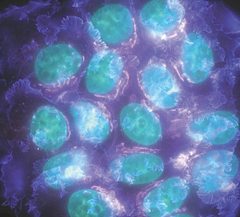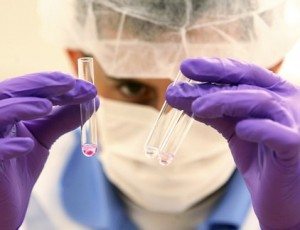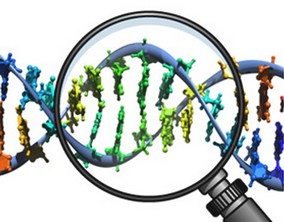Meme kanserinde nüks riski hormon reseptörlerle saptanabilir mi?
 İnsan epidermal büyüme faktörü (HER2) pozitif meme kanserlerinde, hormon reseptör durumundan bağımsız olarak sıklıkla aynı tedavi ile tedavi edilmektedir. BioMed Central Breast Cancer Research dergisinde yeni yayınlanan bir araştırmada, hormon (östrojen ve progesteron) reseptörü (HR) negatif HER2 pozitif kanserli kadınların erken ölüm riskinin ve kanserlerinin kemikte nüks etme ihtimalinin, hormona duyarlı kanserli kadınlara göre daha yüksek olduğunu gösterildi.
İnsan epidermal büyüme faktörü (HER2) pozitif meme kanserlerinde, hormon reseptör durumundan bağımsız olarak sıklıkla aynı tedavi ile tedavi edilmektedir. BioMed Central Breast Cancer Research dergisinde yeni yayınlanan bir araştırmada, hormon (östrojen ve progesteron) reseptörü (HR) negatif HER2 pozitif kanserli kadınların erken ölüm riskinin ve kanserlerinin kemikte nüks etme ihtimalinin, hormona duyarlı kanserli kadınlara göre daha yüksek olduğunu gösterildi.
 Meme kanseri, birçok farklı alt tipi olan heterojen bir hastalıktır. HR pozitif kanser, yüksek olasılıkla luminal A veya B tiptir ve tamoksifen veya aromataz inhibitörlerinin de kullanıldığı endokrin tedavisi ile tedavi edilir, diğer yandan HR negatif kanser, daha çok bazal veya ‘HER2’si yüksek’ tiptir. HER2 pozitif kanserler bu kategorilerin ikisinde de sayılabilir. On üç Ulusal Kapsamlı Kanser Ağı (NCCN) hastanesinden alınan çok merkezli bu çalışmada, erken evre HER2 pozitif meme kanseri tanısı alan 3000’den fazla kadından elde edilen veriler analiz edildi. İlk rekürrenste, çalışmadaki kadınların çoğu, kemoterapi ve/veya anti-HER2 tedavisi ile tedavi edilmiştir.
Meme kanseri, birçok farklı alt tipi olan heterojen bir hastalıktır. HR pozitif kanser, yüksek olasılıkla luminal A veya B tiptir ve tamoksifen veya aromataz inhibitörlerinin de kullanıldığı endokrin tedavisi ile tedavi edilir, diğer yandan HR negatif kanser, daha çok bazal veya ‘HER2’si yüksek’ tiptir. HER2 pozitif kanserler bu kategorilerin ikisinde de sayılabilir. On üç Ulusal Kapsamlı Kanser Ağı (NCCN) hastanesinden alınan çok merkezli bu çalışmada, erken evre HER2 pozitif meme kanseri tanısı alan 3000’den fazla kadından elde edilen veriler analiz edildi. İlk rekürrenste, çalışmadaki kadınların çoğu, kemoterapi ve/veya anti-HER2 tedavisi ile tedavi edilmiştir.
 Çalışmanın yarlarından Dr. Ines Vaz-Luis, elde ettikleri verilerle ilgili şu değerlendirmeyi yaptı: “HER2 pozitif meme kanserli bu geniş hasta grubunda, HR varlığı ve sergilenen özellikler, rekürrens paterni ve sağkalım sonuçları arasında anlamlı bir ilişki saptamış bulunmaktayız. Tedaviden sonraki ilk beş yılda, HR pozitif kansere göre daha fazla kadın HR negatif kanserden ölmüştür. Beyin veya kemikteki rekürrens, aynı zamanda reseptör durumu (beyinde daha fazla HR negatif kanser ve kemikte daha fazla HR pozitif kanser) ile de bağlantılıydı. Test edilen rekürren tümörlerin yaklaşık yarısı, çalışma boyunca, progesteron veya östrojen reseptör durumuna (pozitiften negatife veya tam tersi) veya HER2 kaybı durumuna geçmiştir. Bulgularımıza göre, HR durumu, iki farklı HER2 pozitif kanser alt tipi tanımlamaktadır. Bununla mücadele etmek için, HER2-pozitif meme kanserini tedavi etmeye yönelik yeni ilaçları inceleyen çalışmaların, tasarımlarına hormon reseptör durumlarını da eklemesi gerektiği inancındayız.”
Çalışmanın yarlarından Dr. Ines Vaz-Luis, elde ettikleri verilerle ilgili şu değerlendirmeyi yaptı: “HER2 pozitif meme kanserli bu geniş hasta grubunda, HR varlığı ve sergilenen özellikler, rekürrens paterni ve sağkalım sonuçları arasında anlamlı bir ilişki saptamış bulunmaktayız. Tedaviden sonraki ilk beş yılda, HR pozitif kansere göre daha fazla kadın HR negatif kanserden ölmüştür. Beyin veya kemikteki rekürrens, aynı zamanda reseptör durumu (beyinde daha fazla HR negatif kanser ve kemikte daha fazla HR pozitif kanser) ile de bağlantılıydı. Test edilen rekürren tümörlerin yaklaşık yarısı, çalışma boyunca, progesteron veya östrojen reseptör durumuna (pozitiften negatife veya tam tersi) veya HER2 kaybı durumuna geçmiştir. Bulgularımıza göre, HR durumu, iki farklı HER2 pozitif kanser alt tipi tanımlamaktadır. Bununla mücadele etmek için, HER2-pozitif meme kanserini tedavi etmeye yönelik yeni ilaçları inceleyen çalışmaların, tasarımlarına hormon reseptör durumlarını da eklemesi gerektiği inancındayız.”
KAYNAK: Impact of hormone receptor status on patterns of recurrence and clinical outcomes among patients with human epidermal growth factor-2-positive breast cancer in the National Comprehensive Cancer Network: a prospective cohort study. Ines Vaz-Luis, Rebecca A Ottesen, Melissa E Hughes, P Kelly Marcom, Beverly Moy, Hope S Rugo, Richard L Theriault, John Wilson, Joyce C Niland, Jane C Weeks, Nancy U Lin. Breast Cancer Research, 2012; 14 (5): R129 DOI: 10.1186/bcr3324
Makalenin tam metnine aşağıdaki linkten ulaşılabilmektedir:
http://breast-cancer-research.com/content/14/5/R129
Abstract
 Introduction: In gene expression experiments, hormone receptor (HR)-positive/human epidermal growth factor-2 (HER2)-positive tumors generally cluster within the luminal B subset; whereas HR-negative/HER2-positive tumors reside in the HER2-enriched subset. We investigated whether the clinical behavior of HER2-positive tumors differs by HR status.
Introduction: In gene expression experiments, hormone receptor (HR)-positive/human epidermal growth factor-2 (HER2)-positive tumors generally cluster within the luminal B subset; whereas HR-negative/HER2-positive tumors reside in the HER2-enriched subset. We investigated whether the clinical behavior of HER2-positive tumors differs by HR status.
Methods: We evaluated 3,394 patients who presented to National Comprehensive Cancer Network (NCCN) centers with stage I to III HER2-positive breast cancer between 2000 and 2007. Tumors were grouped as HR-positive/HER2-positive (HR+/HER2+) or HR-negative/HER2-positive (HR-/HER2+). Chi-square, logistic regression and Cox hazard proportional regression were used to compare groups.
 Results: Median follow-up was four years. Patients with HR-/HER2+ tumors (n = 1,379, 41% of total) were more likely than those with HR+/HER-2+ disease (n = 2,015, 59% of total) to present with high histologic grade and higher stages (P <0.001). Recurrences were recorded for 458 patients. HR-/HER2+ patients were less likely to experience first recurrence in bone (univariate Odds Ratio (OR) = 0.53, 95% Confidence Interval (CI): 0.34 to 0.82, P = 0.005) and more likely to recur in brain (univariate OR = 1.75, 95% CI: 1.05 to 2.93, P = 0.033). A lower risk of recurrence in bone persisted after adjusting for age, stage and adjuvant trastuzumab therapy (OR = 0.53, 95% CI: 0.34 to 0.83, P = 0.005) and when first and subsequent sites of recurrence were both considered (multivariable OR = 0.55, 95% CI: 0.37 to 0.80, P = 0.002).
Results: Median follow-up was four years. Patients with HR-/HER2+ tumors (n = 1,379, 41% of total) were more likely than those with HR+/HER-2+ disease (n = 2,015, 59% of total) to present with high histologic grade and higher stages (P <0.001). Recurrences were recorded for 458 patients. HR-/HER2+ patients were less likely to experience first recurrence in bone (univariate Odds Ratio (OR) = 0.53, 95% Confidence Interval (CI): 0.34 to 0.82, P = 0.005) and more likely to recur in brain (univariate OR = 1.75, 95% CI: 1.05 to 2.93, P = 0.033). A lower risk of recurrence in bone persisted after adjusting for age, stage and adjuvant trastuzumab therapy (OR = 0.53, 95% CI: 0.34 to 0.83, P = 0.005) and when first and subsequent sites of recurrence were both considered (multivariable OR = 0.55, 95% CI: 0.37 to 0.80, P = 0.002).
As compared with patients with HR+/HER2+ disease, those with HR-/HER2+ disease had significantly increased hazard of early, but not late, death (hazard ratio of death zero to two years after diagnosis = 1.92, 95% CI: 1.28 to 2.86, P = 0.002, hazard ratio of death two to five years after diagnosis = 1.55, 95% CI: 1.19 to 2.00, P = 0.001; hazard ratio of death more than five years after diagnosis = 0.81, 95% CI: 0.55 to 1.19, P = 0.285, adjusting for age, race/ethnicity, stage at diagnosis, grade and year of diagnosis).
Conclusions: Presenting features, patterns of recurrence and survival of HER2-positive breast cancer differed by HR status. These differences should be further explored and integrated in the design of clinical trials.
YAZIYI PAYLAŞ


 Erken evre meme kanserinde hasta seçimi ve teknik standartlar
Erken evre meme kanserinde hasta seçimi ve teknik standartlar Metastatik kanserlerde hedefe yönelik tedavi seçenekleri artıyor
Metastatik kanserlerde hedefe yönelik tedavi seçenekleri artıyor Lokal ileri meme kanserinde, radyoterapinin rolü ve tedavi alanlarının seçimi
Lokal ileri meme kanserinde, radyoterapinin rolü ve tedavi alanlarının seçimi FDA, erken evre meme kanserinde pertuzumab tedavisini onayladı
FDA, erken evre meme kanserinde pertuzumab tedavisini onayladı Pertuzumab, Herceptin ve dosetaksel kombinasyonu meme kanseri tedavisinde ne kadar etkili?
Pertuzumab, Herceptin ve dosetaksel kombinasyonu meme kanseri tedavisinde ne kadar etkili?
YORUMUNUZ VAR MI?